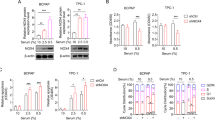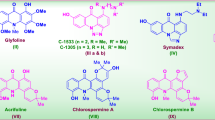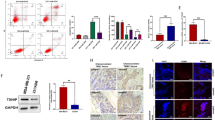Summary
The doxorubicin-selected, P-glycoprotein (P-gp)-expressing human sarcoma cell line MES-Dx5 showed the following levels of resistance relative to the non-P-gp-expressing parental MES-SA cells in a 72 h exposure to cytotoxic drugs: etoposide twofold, doxorubicin ninefold, vinblastine tenfold, taxotere 19-fold and taxol 94-fold. GF120918 potently reversed resistance completely for all drugs. The EC50s of GF120918 to reverse resistance of MES-Dx5 cells were: etoposide 7 ± 2 nM, vinblastine 19 ± 3 nM, doxorubicin 21 ± 6 nM, taxotere 57 ± 14 nM and taxol 91 ± 23 nM. MES-Dx5 cells exhibited an accumulation deficit relative to the parental MES-SA cells of 35% for [3H]-vinblastine, 20% for [3H]-taxol and [14C]-doxorubicin. The EC50 of GF120918, to reverse the accumulation deficit in MES-Dx5 cells, ranged from 37 to 64 nM for all three radiolabelled cytotoxics. [3H]-vinblastine bound saturably to membranes from MES-Dx5 cells with a K D of 7.8 ± 1.4 nM and a B max of 5.2 ± 1.6 pmol mg–1 protein. Binding of [3H]-vinblastine to P-gp in MES-Dx5 membranes was inhibited by GF120918 (K i = 5 ± 1 nM), verapamil (K i = 660 ± 350 nM) and doxorubicin (K i = 6940 ± 2100 nM). Taxol, an allosteric inhibitor of [3H]-vinblastine binding to P-gp, could only displace 40% of [3H]-vinblastine (K i = 400 ± 140 nM). The novel acridonecarboxamide derivative GF120918 potently overcomes P-gp-mediated multidrug resistance in the human sarcoma cell line MES-Dx5. Detailed analysis revealed that five times higher GF120918 concentrations were needed to reverse drug resistance to taxol in the cytotoxicity assay compared to doxorubicin, vinblastine and etoposide. An explanation for this phenomenon had not been found.
Similar content being viewed by others
Article PDF
Change history
16 November 2011
This paper was modified 12 months after initial publication to switch to Creative Commons licence terms, as noted at publication
References
Barrand, MA, Heppel-Parton, AC, Wright, KA, Rabbits, PH & Twentyman, PR (1994). A 190k protein overexpressed in non-P-glycoprotein containing MDR cells and its relation to the MRP gene. J Natl Cancer Inst 86: 110–117.
Boer, R, Dichtl, M, Borchers, C, Ulrich, WR, Marecek, JF, Prestwich, GD, Glossmann, H & Striessing, J (1996). Reversible labeling of a chemosensitizer binding domain of P-glycoprotein with a novel 1,4-dihydropyridine drug transport inhibitor. Biochemistry 35: 1387–1396.
Callaghan, R, Berridge, G, Ferry, DR & Higgins, CF (1997). The functional purification of P-glycoprotein is dependent on maintenance of a lipid protein inter-face. Biochem Biophys Acta Biomembranes 1328: 109–124.
Chen, G, Jaffrezou, J-P, Fleming, WH, Duran, GE & Sikic, BI (1994). Prevalence of multidrug resistance related to activation of the mdr1 gene in human sarcoma mutants derived by single-step doxorubicin selection. Cancer Res 54: 4980–4987.
Cole, SPC, Bhardwaj, G, Gerlach, JH, Mackie, JE, Grant, CE, Almquist, KC, Stewart, AJ, Kurz, E, Duncan, AMV & Deeley, RG (1992). Over-expression of a transporter gene in a multidrug resistant human lung cancer cell line. Science 258: 1650–1653.
Davies, R, Budworth, J, Riley, J, Snowden, R, Gescher, A & Gant, T (1996). Regulation of P-glycoprotein 1 and 2 gene expression and protein activity in two MCF-7/Dox cell line subclones. Br J Cancer 73: 307–315.
Day, S, Ramachandra, M, Pastan, I, Gottesman, MM & Ambudkar, SV (1997). Evidence for two non-identical drug-interaction sites in the human P-glycoprotein. Proc Natl Acad Sci USA 94: 10594–10599.
DeLean, A, Hancock, AA & Lefkowitz, RJ (1981). Validation and statistical analysis of a computer modelling method for quantitative analysis of radioligand binding data for mixtures of pharmacological receptor subtypes. Mol Pharmacol 21: 5–16.
Endicott, JA & Ling, V (1989). The biochemistry of P-glycoprotein-mediated multidrug resistance. Annu Rev Biochem 58: 137–171.
Ferry, DR, Russell, MA & Cullen, MH (1992). P-glycoprotein possesses a 1,4-dihydropyridine-selective drug acceptor site which is allosterically coupled to a vinca alkaloid-selective binding site. Biochem Biophys Res Commun 188: 440–445.
Ferry, DR, Russell, MA & Kerr, DJ (1994). [3H]-Taxol binds to a drug acceptor site which is allosterically coupled to the vinblastine-selective site of P-glycoprotein. Proc Am Assoc Cancer Res 35: 348.
Ferry, DR, Malkhandi, J, Russell, MA & Kerr, DJ (1995a). Dexniguldipine-HCl is a potent allosteric modulator of [3H]-vinblastine binding to P-glycoprotein of MCF-7 ADR breast cancer cell membranes. Biochem Pharmacol 49: 1851–1861.
Ferry, DR, Malkhandi, PJ, Russell, MA & Kerr, DJ (1995b). Allosteric regulation of [3H]vinblastine binding to P-glycoprotein of MCF-7 ADR cells by dexniguldipine. Biochem Pharmacol 49: 1851–1861.
Ferry, DR, Russell, MA, Kerr, DJ, Correa, ID & Prakash, SR (1996). [3H]-GG918 (GF120918) binds with positive co-operativity to human P-glycoprotein with a nM dissociation constant. Proc Am Assoc Cancer Res 37: abstract 2246.
Ferry, D, Moore, M, Bartlett, NL, Fyfe, D, Oza, G, Fracasso, PM, Kersey, K, Wissel, PS, Jewell, RC & Paul, EM (1998). Phase I and pharmacokinetic (PK) study targeting a 500 ng/ml plasma concentration of the potent multidrug resistance (MDR) modulator GF120918 (GF) with doxorubicin (DOX) in patients with advanced solid tumors. Proc Am Soc Clin Oncol 17: 240a.
Ford, JM & Hait, WN (1990). Pharmacology of drugs that alter multidrug resistance in cancer. Pharmacol Rev 42, (3): 155–199.
Gosland, MP, Lum, BL & Sikic, BI (1989). Reversal by cefoperazone of resistance to etoposide, doxorubicin, and vinblastine in multidrug resistant human sarcoma line. Cancer Res 49: 6901–6905.
Gottesman, MM & Pastan, P (1993). Biochemistry of multidrug resistance mediated by the multidrug transporter. Annu Rev Biochem 62: 385–427.
Harker, WG & Sikic, BI (1985). Multidrug (pleiotropic) resistance in doxorubicin selected variants of the human sarcoma cell line MES-SA. Cancer Res 45: 4091–4096.
Harker, WG, MacKintosh, FR & Sikic, BI (1983). Development and characterization of a human sarcoma cell line, MES-SA, sensitive to multiple drugs. Cancer Res 43: 4943–4950.
Hyafil, F, Vergely, C, Du, VP & Grand, PT (1993). In vitro and in vivo reversal of multidrug resistance by GF120918, an acridonecarboxamide derivative. Cancer Res 53, (19):4595–4602.
Kajiji, S, Dreslin, JA, Grizzuti, K & Gros, P (1994). Structurally distinct MDR modulators show specific pattern of reversal against P-glycoproteins bearing unique mutations at serine (939/941). Biochem 33, (17):5041–5048.
Malkhandi, PJ, Ferry, DR, Boer, R & Kerr, DJ (1995). P-glycoprotein has a drug acceptor site for 1,4-dihydropyridines which is localised on an intracellular domain. Proc Am Assoc Cancer Res 36: 332.
Miller, TP, Grogan, TM, Dalton, WS, Spier, CM, Scheper, RJ & Salmon, SE (1991). P-glycoprotein expression in malignant lymphoma and reversal of clinical drug resistance with chemotherapy plus high dose verapamil. J Clin Oncol 9: 17–24.
Mosmann, T (1983). Rapid colorimetric assay for cellular growth and survival: application to proliferation and cytotoxicity assays. J Immunol Methods 65: 55–63.
Planting, A, van der Gaast, A, Sparreboom, A, van der Burg, MEL, de Boer, M, Wissel, PS, Jewell, RC, Paul, EM & Verweij, J (1998). Phase I and pharmacokinetic (PK) study targeting a 100 ng/ml plasma concentration of the potent multidrug resistance (MDR) modulator GF120918 (GF) with doxorubicin (DOX) in patients with advanced solid tumors. Proc Am Soc Clin Oncol 17: 199a.
Raviv, Y, Poland, HB, Bruggermann, EP, Pastan, I & Gottesman, MM (1990). Photosensitive labeling of a functional multidrug transporter in living drug resistant tumour cells. J Biol Chem 265: 3975–3980.
Sambrook, J, Fritsch, EF & Maniatis, T (1989). Transfer of proteins from SDS-polyacrylamide gels to solid supports: immunological detection of immobilized proteins (Western blotting). In: Laboratory Cloning, a Laboratory Manual, Nolan C (ed) Cold Spring Harbor Laboratory Press: New York, pp. 18.60–18.75.
Scheper, RJ, Broxterman, HJ, Scheffer, GL, Kaaijk, P, Dalton, WS, van Heijningen, THM, van Kalken, CK, Slovak, ML, de Vries, EGE, van der Valk, P, Meijer, CJLM & Pinedo, HM (1993). Overexpression of a Mr 110 000 vesicular protein in non-P-glycoprotein-mediated multidrug resistance. Cancer Res 53: 1475–1479.
Schibler, MJ & Cabral, F (1986). Taxol-dependent mutants of chinese hamster ovary cells with alterations in alpha-tubulin and beta-tubulin. J Cell Biol 102: 1522–1531.
Shapiro, AB, Ling, V & Doige, CA (1995). Reconstitution of drug transport by purified P-glycoprotein. J Biol Chem 270: 16167–16175.
Sonneveld, P, Durie, BGM, Lokhorst, HM, Marie, J-P, Solbu, G, Zittoun, R, Lowenberg, B & Nooter, K (1992). Modulation of multidrug resistant myeloma by cyclosporin. Lancet 340: 255–258.
Spoelstra, EC, Westerhoff, HV, Dekker, H & Lankelma, J (1992). Kinetics of daunorubicin transport by P-glycoprotein of intact cells. Eur J Biochem 207: 567–579.
Witherspoon, SM, Emerson, DL, Kerr, BM, Lloyd, TL, Dalton, WS & Wissel, PS (1996). Flow cytometric assay of modulation of P-glycoprotein function in whole blood by the multidrug resistance inhibitor GG918. Clin Cancer Res 2: 7–12.
Author information
Authors and Affiliations
Rights and permissions
From twelve months after its original publication, this work is licensed under the Creative Commons Attribution-NonCommercial-Share Alike 3.0 Unported License. To view a copy of this license, visit http://creativecommons.org/licenses/by-nc-sa/3.0/
About this article
Cite this article
Traunecker, H., Stevens, M., Kerr, D. et al. The acridonecarboxamide GF120918 potently reverses P-glycoprotein-mediated resistance in human sarcoma MES-Dx5 cells. Br J Cancer 81, 942–951 (1999). https://doi.org/10.1038/sj.bjc.6690791
Received:
Revised:
Accepted:
Published:
Issue date:
DOI: https://doi.org/10.1038/sj.bjc.6690791
Keywords
This article is cited by
-
Cytochrome P450 3A4, 3A5, and 2C8 expression in breast, prostate, lung, endometrial, and ovarian tumors: relevance for resistance to taxanes
Cancer Chemotherapy and Pharmacology (2019)
-
Increased cellular accumulation and distribution of amrubicin contribute to its activity in anthracycline-resistant cancer cells
Cancer Chemotherapy and Pharmacology (2012)
-
Beyond DNA binding - a review of the potential mechanisms mediating quinacrine's therapeutic activities in parasitic infections, inflammation, and cancers
Cell Communication and Signaling (2011)
-
Assessment and modulation of phillyrin absorption by P-gp using Caco-2 cells and MDR1-MDCKII cells
European Journal of Drug Metabolism and Pharmacokinetics (2011)



